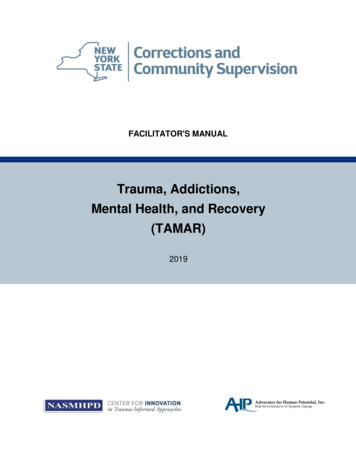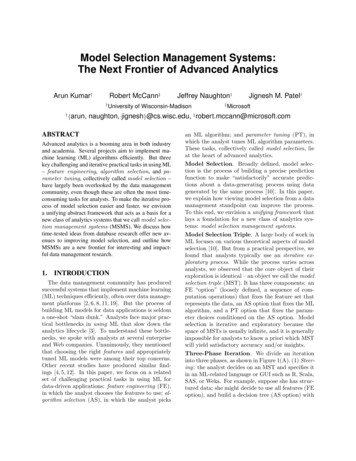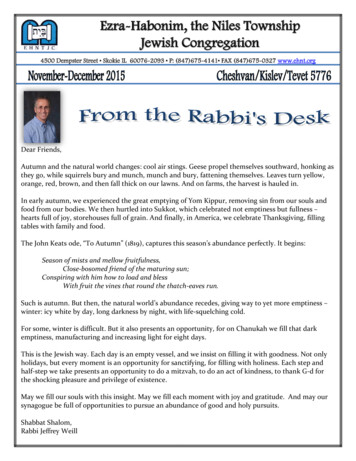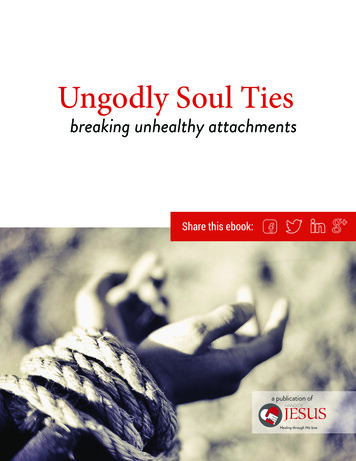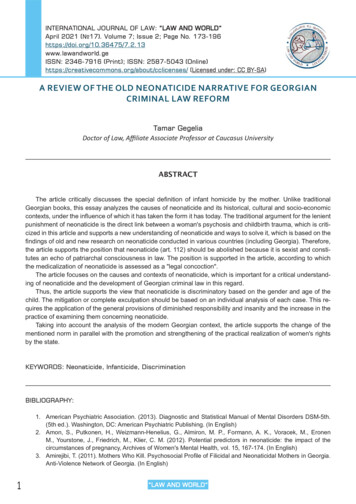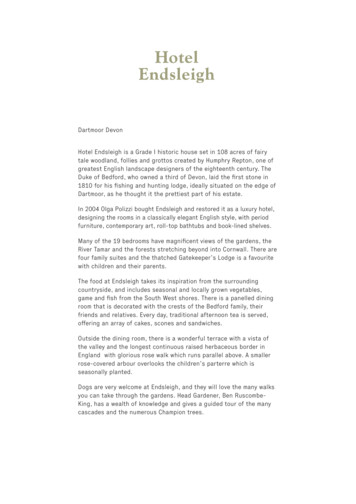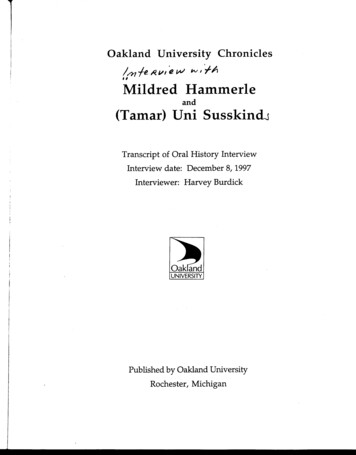
Transcription
Oakland UniversityiIImfe.AI/IChroniclese W wl'fAMildredHammerleand(Tamar) Uni Susskind Transcript of Oral History InterviewInterview date: December 8, 1997Interviewer:Harvey BurdickPublished by Oakland UniversityRochester, Michigan
Oakland UniversityChroniclesMildred Hammerleand(Tamar) Uni SusskindTranscript of Oral History InterviewInterview date: December 8, 1997Interviewer:Harvey BurdickContentsPrefaceAbout the Oakland University ChroniclesEditing of the TranscriptsIntroduction to InterviewBiographical Sketch of Mildred HammerlePhotographof Mildred Hammerle Taken December 8, 1997Photographof Mildred Hammerle Taken Before 1959Biographical Sketch of Uni SusskindPhotograph of Uni Susskind Taken December 8, 1997Photograph of Uni Susskind Taken Before 1960Biographical Sketch of InterviewerTranscript of Oral History InterviewTranscript of the Interview:27 PagesIndex of Topics in the Transcript
Oakland University ChroniclesMILDRED ORTALS HAMMERLEDate of birth: April 3, 1919EDUCATIONWest Philadelphia Catholic High School for GirlsPRIOR TO OAKLAND UNIVERSITYLived in East Lansing with husband William Hammerle,who taught at Michigan State University.ASSOCIATION WITH OAKLAND UNIVERSITYHer husband Professor William Hammerle taught chemistry,physics, and engineering from 1959 until his death in 1986.EMPLOYMENT AND OTHER ACTIVITIESSecretary, CIPO (Campus Information and Programs Office)Oakland UniversityBoard member and negotiating team memberUAW Local 1925Cub Scouts den motherLibrary volunteer at Meadow Brook Elementary SchoolCHILDRENMichael Louis December 1955Patricia Ann April 1957Current as of December 8, 1997
Photograph of Mildred HammerleDecember 8, 1997Photographer: Alice Tomboulian
Photograph of Mildred HammerlePhotograph taken before 1959Source: Loan from Mildred Hammerle
Oakland University ChroniclesTAMAR YOUNINAH “UNI” SUSSKINDDate of birth: August 28, 1930EDUCATIONB.A.University of British ColumbiaM.S.Oakland UniversityMajor: Chemistry19501970PRIOR TO OAKLAND UNIVERSITYLived in Columbus, Ohio with husband Norman Susskind, who taught atOhio State University.ASSOCIATION WITH OAKLAND UNIVERSITYHer husband Professor Norman Susskind taught Frenchlanguage and literature from 1960 until his death in 1990.EMPLOYMENTInstructor: ChemistryOakland Community CollegeOakland County, Michigan1965 - presentCHILDRENDavid Lawrence February 1956Robert Daniel October 1957Judith Anne June 1961Current as of December 8, 1997
Photograph of Uni SusskindDecember 8, 1997Photographer: Alice Tomboulian
Photograph of Uni SusskindPhotograph taken before 1960Source: Loan from Uni Susskind.
Oakland University ChroniclesInterview withMILDRED HAMMERLE and (TAMAR) UNI SUSSKINDDecember 8, 1997HARVEY BURDICK: Today‟s interview is one in a series of interviews beingconducted for the Oakland University Chronicles Project and supported in itssecond year by a special university allocation. The purpose of the interviews is todevelop an oral history of the early years of Oakland University, then called MSUO.The interviews are being conducted with various members of the MSUOcommunity: administrators, faculty and their wives, as well as students and othersfrom those early days.Today is December the 8th, 1997, and we are in Varner Hall on the campus ofOakland University. My name is Harvey Burdick and I am a professor ofpsychology and will do the interviewing on this occasion.Our guests today were wives of early faculty members. Millie Hammerle,directly to my right, was married to Bill [William] Hammerle who was a professorof physics and engineering until his death in 1986. Uni Susskind was married toNorman Susskind, who was a professor of French in the modern language[department] until his death in 1990.Both Millie and Uni have maintained their contact with Oakland and bothcontinue to live in the university subdivision. I would like to welcome you both tothe Chronicles Project and thank you for contributing your memories of those earlyyears.Why don‟t we start with Millie, okay? Millie, could you tell us about Bill‟sacademic background, when you were married, and how you finally came toMSUO?MILDRED HAMMERLE: Bill was a grad student at Princeton and I was workingat the Textile Research [Institute]. We met in January of 1952 and after Bill passedprelims we were married. Then in the following June when he got his Ph.D. wemoved to Yale. Yale was very formal and I was surprised because new wives didnot speak to faculty wives until they were properly introduced. The faculty wiveswould make a call wearing hats and white gloves. They didn‟t
2care whether you were home or not, that was considered an introduction, and itwas very unusual.HARVEY BURDICK: So you were a young wife. What was Bill doing at Yale?MILDRED HAMMERLE: He was on a post-doctoral fellowship in the physicsdepartment.HARVEY BURDICK: And you were a young wife who had to deal with all of theothers in a very formal fashion; is that your recollection of Yale?MILDRED HAMMERLE: Yes, it was very formal.HARVEY BURDICK: And you were in Yale for what, a couple of years?MILDRED HAMMERLE: Two years.HARVEY BURDICK: And then?MILDRED HAMMERLE: Then Bill was offered a job at Michigan State in thephysics department. Michael had been born while we were living in New Havenand Michael and Bill and I moved to East Lansing, and while we were in EastLansing our daughter Patti was born. Bill taught there for three or four years, andwhile he was there Woody [Durward B.] Varner was also there and spoke withsomeone in the physics department about this new university. He was looking forprofessors, and one of the professors recommended Bill.HARVEY BURDICK: So Woody Varner got in touch with Bill?MILDRED HAMMERLE: I was doing the laundry, hanging it out, and Woodycame along and said, “You must be Millie,” which was very different from Yale. Isaid, “Yes,” and he said, “Well, I‟m Woody Varner and we have this newuniversity, and I‟ve come to talk to Bill.” And Bill spoke to him and seemed veryinterested and said he would think about it. He didn‟t think about it too longbefore saying yes.
3HARVEY BURDICK: When was that, do you remember the month?MILDRED HAMMERLE: That was in June.HARVEY BURDICK: That was in June, and Bill came that very September, so thishappened very quickly?MILDRED HAMMERLE: Very quickly. We spent the summer in Calumet[Michigan] and Bill made a couple of trips down to see how the university wasprogressing and I think he was always impressed with it.HARVEY BURDICK: So the interview with Bill was in June, you then spent thesummer in northern Michigan and came to campus in the fall, in August?MILDRED HAMMERLE: We came down for the first time in August and that waswhen I first saw the campus. There were two buildings, North and SouthFoundation. South Foundation didn‟t have doors yet, and I was impressed that wewent into the building through the windows. It was fun looking for a place to live,or to stay while we were here for the short visit. There were only two motels andwe stayed at the Rochester Motel on Main Street for that short time and then wentback.HARVEY BURDICK: And found a place to rent during that time—MILDRED HAMMERLE: When we lived at the Rochester Motel, we stayed fortwo weeks and we looked for housing in Rochester and couldn‟t find any. Thenwe went to Pontiac and found a house on Featherstone Road.HARVEY BURDICK: O.K. So you found a place to come back to in September?MILDRED HAMMERLE: In September.HARVEY BURDICK: You got that solid. You are secure, you have a place tostay, you have two kids, and you‟re going to begin a new life in this two-buildinguniversity?
4MILDRED HAMMERLE: Yes.HARVEY BURDICK: Can you tell us your reaction? Was it, “My God, thisdoesn‟t look like a university, certainly not like Yale or MSU?”MILDRED HAMMERLE: Oh, I kind of thought it was great. I was willing to goanywhere. If Bill was going to be happy there, it was fine with me. I thoughtRochester was kind of special because the people were really very nice to us whenwe came—people in town, the people at the restaurants were interested in thekids—and it was very different from sort of being nobody to just being part of thecommunity.HARVEY BURDICK: There was a feeling of friendliness that was special—MILDRED HAMMERLE: That was special, yes.HARVEY BURDICK: That‟s interesting. Where did you go to eat?MILDRED HAMMERLE: We ate at Red Knapp‟s for breakfast and a restaurantcalled Gerda‟s for dinner.HARVEY BURDICK: I don‟t think I know that place. Is it still in existence?MILDRED HAMMERLE: No, it didn‟t last too long after we came. It was just agood place to be.HARVEY BURDICK: So we've got you settled in; this is in 19—MILDRED HAMMERLE: „59.HARVEY BURDICK: Really right at the beginning of the university. You and allof the students were brand-new?MILDRED HAMMERLE: Right.
5HARVEY BURDICK: Let me turn to you, Uni, because you came at a differenttime, didn‟t you?UNI SUSSKIND: A year later.HARVEY BURDICK: Tell us about your background and Norm‟s.UNI SUSSKIND: Well, I met Norman in the early „50s and he was still going toschool while I had already graduated from U.B.C. [University of British Columbia],because I gained some extra years, I guess, in the process of moving. He then wentto Yale as a graduate student. I would visit with him and by the summer of 1952we got married. About 3 months after we got married he went into the service.He just simply allowed himself to be drafted, so he was in the Korean War, butfortunately he was sent to Europe, to Frankfurt am Main, because he knew somelanguages. So shortly after we were married he left, and I stayed behind to workin the metal finishing industry, because of my chemistry background, and livedwith his parents. When he came back we moved to Yale, to New Haven.HARVEY BURDICK: Before he went into the army, was he started at Yale?UNI SUSSKIND: He had started—HARVEY BURDICK: He had started, so now he comes back to finish up.UNI SUSSKIND: So now he comes back to finish up. We spent three years, andin the meantime David was born at Grace New Haven Hospital, at Yale. We livedin the Quonset huts, which is right across from the Yale Bowl, at 43 a month, allthe coal you can burn and a little pot-bellied stove that sort of heated half of aQuonset hut. It was wonderful living there, because we were all producing babiesand we all were about the same age, and we were all graduate students and wivesand married students.HARVEY BURDICK: And he finishes up when?
6UNI SUSSKIND: And he finishes up in 1957. Then the first assignment he hadwas at Ohio State University, in Columbus, Ohio. So we moved there. I waspregnant with Bob, and my second son was born actually in Columbus. Columbusseemed like where Norman would probably land a very good job and stay. Hewas going to fill a position where. His work was in Romance philology and hisspecialty was in medieval French, but he taught beginning French for three years.It was clear that he was not going to move into his specialty.So by the third year he was looking for work. When he went to the MLA[Modern Language Association] meeting which normally meets around Christmastime, between Christmas and New Year‟s, he met an old friend, Francis Tafoya,who was here in the first year. Francis Tafoya approached him about coming toOakland University, and he described what was going on here and this excitedNorman very much.HARVEY BURDICK: He sort of told him about this new school, starting fromscratch.UNI SUSSKIND: Starting from scratch, clean slate, we can sort of do what wethink ought to be done; and the fact that the faculty were going to be bright andyoung and virile and we can just simply build on the good foundation that theyhad. So it was very exciting, and shortly after that he came down to Oakland.One thing that I remember him saying, when he looked for a motel room inRochester, there was this Spartan Motel in Rochester then, that‟s wherever they putthe candidates.HARVEY BURDICK: That was the name of the motel?UNI SUSSKIND: Yes. It still survives, the Spartan Motel, and Norman, when hecalled up, said to the person on the phone, “I trust that your facilities are Spartan.”And the telephone operator said, “Oh yes sir, yes, they are quite Spartan.”HARVEY BURDICK: Very proud of it, too.
7UNI SUSSKIND: Very proud of it, exactly. Well, anyway, I think probably thefacilities were Spartan but that didn‟t bother Norman. He looked around at theuniversity, saw North and South Foundation Hall; that‟s what existed at that time,too. So within the year, I think maybe, they were starting to build the studentcenter, but that was the next thing that went up.HARVEY BURDICK: What year was this we‟re talking about?UNI SUSSKIND: We‟re talking about—we came in „60, for the September of thesecond year.HARVEY BURDICK: „59 was the first year?UNI SUSSKIND: „59 was the first year; we came and Norman started teaching in„60. So we moved, actually, in June of „60. And while Norman was here, ormaybe at a later visit, he looked for housing. He was offered the position clearly,and dare I say what he made then at that time?HARVEY BURDICK: Sure, you can tell us. Tell us everything.UNI SUSSKIND: At Ohio State, it was 4,800 a year, and [MSUO] seemed awfullygood because he was offered a job at 6,500 a year, so that was quite nice.HARVEY BURDICK: That was a nice raise in salary.UNI SUSSKIND: Nice raise in salary, yes. And Norman found a house onFeatherstone Road. It seemed to be [where] all the beginning [faculty looked].HARVEY BURDICK: Featherstone, that was a very popular place to find a house.UNI SUSSKIND: Very popular place, right across the street from the presentPontiac Silverdome. I think it was 1295 Featherstone Road, somehow that rings abell in my head. We moved in with our two children. We were renting a house.The reason we rented was because we were quite attracted to the faculty
8subdivision, but we just wanted to make sure that that was the place we were goingto be.HARVEY BURDICK: [To Millie] And you were living on Featherstone also?MILDRED HAMMERLE: We were living on Featherstone also.HARVEY BURDICK: And when the Susskinds moved in, were you aware ofthat—that you were neighbors—that you recall?MILDRED HAMMERLE: Yes. The Obears moved in shortly after that too. Itwas sort of like faculty row for a little while.HARVEY BURDICK: Interesting, everybody sort of waiting for the [faculty]subdivision to become available for them. Is that one of the factors?MILDRED HAMMERLE: I think that was one of the factors.HARVEY BURDICK: Were you also interested in building a home in thesubdivision?MILDRED HAMMERLE: Yes. It was the only place we could afford to build ahome.HARVEY BURDICK: Well we ought to spend some time and talk about thatsubdivision, don‟t you think? Let‟s see, I just want to make sure we've got you alltogether. You‟re here in „59, a year‟s gone by, it‟s „60 and the Susskinds come inthat following September. Bill was teaching in the fall?MILDRED HAMMERLE: He taught chemistry the first year and then physics thesecond year.HARVEY BURDICK: All right, so he comes, his background is in physics, but he isalso in physical chemistry and so he teaches chemistry the first year, ready to gointo physics when it becomes available for him.
9MILDRED HAMMERLE: Right.HARVEY BURDICK: Okay, can you tell us your impression of that first year?You came and there were only two buildings, the rest was sort of farm land readyto be built up. And you were renting a place on Featherstone. So how were youfeeling in those days, do you recall?MILDRED HAMMERLE: The students were very interesting. Most of them werethe first in their family to go to college so we met lots of parents. And whenparents had questions, they had no problem calling the faculty to ask if they couldtalk to them about it.HARVEY BURDICK: They called you at your house?MILDRED HAMMERLE: Sure.HARVEY BURDICK: Well that‟s nice and informal.MILDRED HAMMERLE: At your home or at the office, whichever. And Woodywas very good about having meetings with students‟ parents and involving thefaculty. We had parties for the students and there were several joint things likepicnics that included students and faculty. And Mrs. [Matilda Dodge] Wilson wasvery much into enjoying the students and the new faculty. Our first year here shehad a formal dinner for the faculty which was great fun.HARVEY BURDICK: Formal dinner, and you got dressed in gowns and—MILDRED HAMMERLE: Oh, we didn‟t wear gowns and tuxes but we had quite alot of waiters, I think one waiter to each five people.HARVEY BURDICK: Held where?MILDRED HAMMERLE: In Meadow Brook Hall, and she served fillet from herown cattle. She was very delighted to surprise us with meat that she had raised onher farm in Howell.
10HARVEY BURDICK: It was a fairly small faculty and you could gather together atMeadow Brook and feel very intimate with one another. Did you know all thewives of the other faculty?MILDRED HAMMERLE: We knew all the wives, and our first faculty directorylisted all the children and their ages, because there were not too many children inthe neighborhoods where we were scattered. That way, if you needed a playmateyou could call and say, “How about Tuesday afternoon to play in our yard?” Wesort of traded off and on with the kids.HARVEY BURDICK: That‟s nice. So there was right from the beginning a senseof family—MILDRED HAMMERLE: —of family; it was very informal, very friendly, andliving in Pontiac was not a hardship at all.HARVEY BURDICK: When the Susskinds came, did you make an effort to makeUni feel at home? Was that part of the tradition?MILDRED HAMMERLE: I can‟t remember what we did exactly. I thinkeverybody knew when a new faculty person came in, and I think they wereincluded in whatever was going on.HARVEY BURDICK: Well, maybe let me ask Uni. When you came did you havea sense that you were welcomed by the other faculty wives?UNI SUSSKIND: Hammerles—they lived about three blocks away from us—werea little further away than a few of the others that were closer. But we certainlywere aware of that. There were, I think, the Strakas were here—MILDRED HAMMERLE: The Strakas lived two doors from us.UNI SUSSKIND: He [Gerald Straka] taught in history, and the Obears were twodoors from us, so we did know exactly where they lived and we did see them quitea bit. In fact, I remember the Tomboulians; I was babysitting for them or
11they were babysitting for us too, as I recall, in the early days. And in fact Jeff wasborn—when was that, in „60—and Jeff was just a little baby, and we switchedbabysitting right there when I lived on Featherstone.HARVEY BURDICK: We had talked earlier, and I remember you mentionedsomething about the faculty wives club. Maybe you can talk a little bit about that,because that‟s sort of being in contact with one another, right? What kind of thingsdid this club do?MILDRED HAMMERLE: They had everything.UNI SUSSKIND: Gourmet clubs, bridge clubs. I think they probably helpedin—there was square dancing, not a club, but we met for square dancing once amonth.MILDRED HAMMERLE: There was a book exchange. If any of the faculty wiveswere sick or needed help, the others wives would pitch in and do cooking orbabysitting. They were very helpful.UNI SUSSKIND: We were small enough so that we understood our interests.And I think there were people who played recorder. We had recorderget-togethers and music and readings.HARVEY BURDICK: I also have the sense that you were all of the samegeneration; you weren‟t exactly the same age, but you were close to the same age,weren‟t you? So you had a lot in common.UNI SUSSKIND: Within 5 to 10 years, I think, yes.HARVEY BURDICK: And a number were young, giving birth, so if they went intothe hospital, would you bring the potluck for the family?MILDRED HAMMERLE: For the family at home.
12HARVEY BURDICK: So really there were lots of factors that brought youtogether. Not only were you brand-new at this brand-new university, but youwere of the same age, had a lot of the same interests or common interests.MILDRED HAMMERLE: Right.HARVEY BURDICK: And that generated what? Give us a sense of what thatcommunity felt like to you; can you?MILDRED HAMMERLE: Well, to me it was a sense of belonging. You were athome wherever you went on the campus or visiting other people. Mrs. Wilsonwas part of the bridge club. She always drove her own car and she always tookher turn at having bridge at Sunset Terrace. She was great fun to play with andshe was a marvelous bridge player. She enjoyed the students, she loved doinganything that involved the students. She was interested, I think, in the children ofthe faculty, and if you had a problem she would listen.HARVEY BURDICK: It was if she had made a new family for herself, in a way.She sort of worked with the wives and the other people at the university, thestudents and so on, and was open to them.MILDRED HAMMERLE: Yes.HARVEY BURDICK: So did you play bridge with her also, Uni?UNI SUSSKIND: Oh yes, she was in my house after we moved into the [faculty]subdivision, so I remember that very well. And we were—as Millie said—weplayed bridge with her at Sunset Terrace. Those were in my bridge playing days;now I play once every five years, if I can remember. We did play bridge and it wasfun.HARVEY BURDICK: And Woody Varner‟s wife, was she also involved in thesesessions?
13MILDRED HAMMERLE: She was involved in everything. She was verycharming, she was a delight.UNI SUSSKIND: I think Paula and Woody were such wonderful hosts, andWoody had an uncanny memory. He remembered everyone‟s name and thewives‟ names so it really felt like a big family. When he had the faculty over to hishouse at the beginning of the year he would mention everyone‟s name. It wasamazing to me. He also remembered what you wore. He was also attuned intosomething that was new, and I remember him saying, “You have a new dress, Uni, Ican see that.” It was sort of amazing to me that there was this welcoming andfeeling a part of [the group]. He was not at a different level in any sense of theword. This is a university that was being put together by everyone there, and Ithink the wives felt that: that sense of pioneering, of building something, ofstarting from scratch.HARVEY BURDICK: And very informal with one another in contrast to yourexperience at Yale.MILDRED HAMMERLE: Yes.HARVEY BURDICK: So you called Woody “Woody,” and Paula “Paula,” but Mrs.Wilson you called “Mrs. Wilson,” I bet.MILDRED HAMMERLE: Mrs. Wilson was always “Mrs. Wilson.”UNI SUSSKIND: Yes, I think so, yes.HARVEY BURDICK: Go on, tell us about the kinds of gatherings. Were therelots of people giving dinner parties at that time, a sense of people gatheringtogether, doing things together socially?UNI SUSSKIND: Something was happening all the time. That‟s the way that Iremember it.HARVEY BURDICK: A week wouldn‟t go by without something happening?
14MILDRED HAMMERLE: That‟s right.UNI SUSSKIND: Right, that‟s right.MILDRED HAMMERLE: One of the things the wives did together was to haveinternational coffees. And Mrs. Wilson allowed us to use either Sunset Terrace orMeadow Brook Hall for those, and all the wives made special cookies or something,and we did a cook book. Then with the money that we made on that, we used thattoward a scholarship fund.HARVEY BURDICK: These are the faculty wives again.MILDRED HAMMERLE: The faculty wives again did that.HARVEY BURDICK: Those were the faculty wives across wherever they wereliving. Now you are starting to live in a particular subsection of the university, thesubdivision where it was set up for administrators and faculty, right?MILDRED HAMMERLE: Right.HARVEY BURDICK: And Uni, you were very quick to move in, into thesubdivision.UNI SUSSKIND: Yes, I think because of David. By that year we were thinkingabout his going into kindergarten, and I just wanted to find a school and wanted togo into the Rochester school district. We figured that after a year we probablywould want to know where we‟d live, and this faculty sub looked very inviting.The choice lots, I think, were taken by the time we were there, but we still found alot that had a couple of good-sized trees, because the center lots did not, they werevery clear. The choice of the lot we made was partly because of the deer we couldsee from our potential window, kitchen window; there were always these deer thatwe could see from across the road.HARVEY BURDICK: These were the deer that go with—
15UNI SUSSKIND: —with Mrs. Wilson‟s estate, the white deer. So we chose a lotand we actually started to build shortly after that in the dead of winter, in February,hoping to move in by May of ‟61, because I was pregnant with my daughter. Ididn‟t know that she was a daughter at that time, but she was due around May of„61, and so was the house. We managed to move into the house about a weekbefore she was born.HARVEY BURDICK: So by the end of your very first year, you had moved into ahouse in the subdivision?UNI SUSSKIND: Yes, we stayed at Featherstone Road for one year and by the endof [that] year we were—you‟re right, by „61 we were there.HARVEY BURDICK: Yes, because you came in September of „60 and by—UNI SUSSKIND: —by May of „61 we were in [our new house], that‟s right.HARVEY BURDICK: [To Millie] And you continued to live at Featherstone for awhile?MILDRED HAMMERLE: We had to move from Featherstone to Bay Street, but itwas still in the same area. We had wanted to build a house sooner, but I think thecost was over the amount that they had as the top limit for houses in the sub at thattime. Then after a while we finally had an architect who was willing to build it,because it was a different sort of house. When they started working on it, theystarted in April and it was supposed to be finished by September, but they didn‟tfinish until December. So we moved in the middle of a snow storm.HARVEY BURDICK: Wow, that‟s never much fun! There was something specialabout the buildings in the subdivision—you didn‟t own your [lot].UNI SUSSKIND: The lure of moving into the subdivision was that actually wedidn‟t own the land, we leased the land for 75 years. And the lure of getting intothe subdivision was the fact that we didn‟t have to buy a lot for three to fourthousand dollars, so that you could spend that money on the house. Now the
16top limit for a house in the subdivision was 25,000 and we, I think, paid 23,000 forour house, and finished some of the things ourselves so that we wouldn‟t get closeto that limit. But there was indeed a top limit, which at that time didn‟t trouble usat all. When you take a look at houses now you—HARVEY BURDICK: It‟s another world.UNI SUSSKIND: It‟s another world, it‟s another world.HARVEY BURDICK: There were other limits on the housing because of the factthat you didn‟t own the property; you were restricted on whom you could sell thehouse to.MILDRED HAMMERLE: We had to agree to sell the house to other faculty oradministrators from the university, but one of the good things about it was that ifyour house was up for sale for six months and you hadn‟t sold it, then theuniversity was obliged to buy it back, at fair market value, you hoped.HARVEY BURDICK: But there was a restriction in the selling.While we‟re talking about the Meadow Brook Subdivision—what I heard isthat there was a very close relationship among the people in the [university]community, even though you were living in different parts. And now you‟recoming together, all living in one small area. One would think that maybe it‟s alittle too much, you know, it gets a little close. What were your experiences overthe years?UNI SUSSKIND: Well, Harvey, I think that people thought that that was going tobe the case, or people who refused to think about living in the subdivision felt thatthat would be the case. But honestly, I have to tell you that even though wedid—or the professors did—work in one place, we managed to keep a wonderful,comfortable distance because we knew everybody there. We didn‟t have to learnour neighbors, we knew our neighbors in one sense. So the regular over-welcoming did not have to be, but you simply welcomed your neighbors but thenkept your distance.
17I think that there were other very positive things with the neighbors in thesubdivision. For example, when we found that we couldn‟t afford a lawn mower,some of us chipped in and shared the lawn mower and other things. But theconstant coffee klatching, constant seeing of neighbors did not happen, and I‟mvery happy about that. And frankly, my friends were not just subdivision people,they were all the faculty, so it was not just a unit within a bigger unit, we justhappened to live there.HARVEY BURDICK: Okay, so the fact that these people came close together inliving did not change the nature of the relationships. You were just as friendly[with people] living elsewhere as you were with the people in the subdivision.UNI SUSSKIND: Yes, that‟s right.HARVEY BURDICK: Was that true for you too?MILDRED HAMMERLE: Yes, that‟s true.HARVEY BURDICK: Although your children—I mean you have to admit that thechildren, because they were close together, became friendly with one another.UNI SUSSKIND: Yes.HARVEY BURDICK: Were there, you know, was there a lot of back and forth withthe kids coming, visiting and so on?UNI SUSSKIND: I think it was rather nice to have the children in the subdivisionthat were the same age as ours. We didn‟t have to drive them back and forth,which I had to do when I lived in Pontiac. So that was nice. I think the childrenhad probably a much tighter community than the adults.HARVEY BURDICK: And they could go anywhere, there was—
18MILDRED HAMMERLE: They could go anywhere, there was a feeling of safety.They just felt they could wander around in the field, or down near the lake, orwherever they felt like going was fine.HARVEY BURDICK: So there was a nice lake in your division?MILDRED HAMMERLE: Yes.HARVEY BURDICK
in the Quonset huts, which is right across from the Yale Bowl, at 43 a month, all the coal you can burn and a little pot-bellied stove that sort of heated half of a Quonset hut. It was wonderful living there, because we were all producing babies and we all were about the same age, and we were all graduate students and wives and married students.

